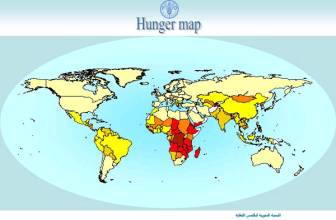|
from The Worldview Literacy Book copyright 2009 back to worldview theme #24 |
|
Discussion One approach to development—to the process of improving the quality of human life, especially in poor countries—is to target the poorest people and help them meet their most basic needs for food, clean water, shelter, clothing, health care and education. To appreciate what a staggering job this is, consider recent global statistics (from UN agencies or reports to them). 1) The world has 850 million hungry, food
insecure people
(13% of its population). Where
are they? See Figure
#24a. 2) Over one billion people on the planet (>15%) lack adequate housing, while around 100 million have no housing whatsoever. 3) More than one
billion people (>15%) lack access to safe drinking water, around
2.6 billion people (40% of population)
currently have insufficient fresh water for minimal hygiene. 4) ~2.7 billion people have no access to
improved sanitation.
Suppose you are an aid worker, readying yourself for your first
experience working directly with hungry, homeless, thirsty, dirty
people—those living in absolute poverty.
In preparation you do some reading about hunger: an
uneasy sensation, craving, or urgent need for food (or specific
nutrient) due to lack of it. Prolonged
lack of food produces a weakened condition.
It is one thing to read statistics and definitions related to
people "Struggling With a Basic Need: Sustenance" and another
to actually be one of those people!
Try to imagine what it would be like.
To have chronic diarrhea, to be unable to absorb nutrients from
the little food you do get to eat given the parasites that live in your
intestines—they're there because your only source of drinking water is
contaminated. As a mother,
to watch your son slowly waste away as he starves.
As a father, unable to get a job because there are none, watching
his eldest daughter pretty herself up before heading out on the streets:
selling her body so the family can eat.
As a homeless wanderer, being
pleased you've found a dry place to sleep tonight—only to have someone
much bigger show up and take it, along with stealing your tattered coat.
To be unable to read—not because
of physical or mental defects, but because you started working factory
jobs at a very young age and never got the opportunity to go to school.
To go to the country's main hospital: where dirt and flies are
everywhere, rats lurk, where they have no drugs, no painkillers—not
even aspirin, where dead bodies often sit for over a day before they are
removed.
You don't have to live in the developing world in a state of
absolute poverty to relate to (perhaps even very strongly identify with)
this worldview theme. Rather it is for anyone who feels 1) their life is a daily
struggle to obtain sustenance, |
Discussion—continued and that
their continued survival is at stake,
2) fear that their death by starvation, exposure, or illness
brought on by lack of food, clean water, or sanitary living conditions
may just be a matter of time—indeed it could just be one bad break or
poor decision away, or 3)
for now, all they want out of life is to have their basic needs met so
they can continue to stay alive: their wants have shrunk to the point
where wants = needs, their thoughts are dominated by what they must do
to obtain their next meal, drink of water, or place to sleep.
For many, obtaining sustenance centers on efforts to grow food
(Figure #24b) on a small patch of land.
While this hard work can be rewarding when times are good and
nature cooperates, it typically is a continuing struggle.
Drought can require hauling water long distances; continuing
harvests and declines in soil fertility necessitate adding nutrients to
it; if fertilizer is too expensive, some can slash and burn; natural
pests—animals, insects, weeds—can
decimate crops requiring new fences and more pesticides—for which
money may be lacking!
The worldviews of those merely trying to stay alive narrow to
focus (see "Focused Vision" theme #3) on matters of
sustenance. In a sense they
are imprisoned (see "Servitude" theme #33A) by their poverty.
Psychologically, many suffer from poor self-esteem (theme #41).
Many have inner thoughts dominated by harm avoidance.
Some with mental illness are nonetheless trying to independently
survive despite their handicap (see theme #52). Those who feel they've been slowly beaten down by society
have likely developed some cynicism (see theme #36A). Some have developed a sense of fatalism (see theme #11A):
becoming resigned to their poverty, feeling that no matter what they do,
since they were destined to be poor, they can’t escape it. Those struggling to eke out a living farming a poor piece
of ground may still have a sense of "Belonging to Nature" (see
theme #27)—but any remnant of ecological groundedness they feel has
most likely long ago been stripped of joyous elements or sense of
stewardship. Many in
desperate circumstances, sensing they have nothing left to lose, quit
caring about things that were once important, and employ a selfish
"end of game strategy" to survive. Figure
#24a: Hunger Map
source: United Nations FAO |
|
|
Figure
#24b: Food Comes From Plants
|

